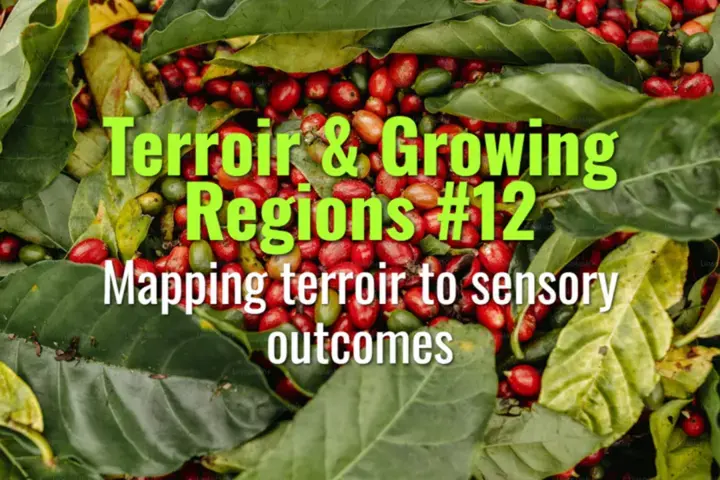Mapping terroir to sensory outcomes
This topic explains how terroir factors such as soil, altitude, climate, and farming practices translate into sensory outcomes in the cup, and how these links are mapped and understood by producers, roasters, and consumers.
- Coffee Basics Nerds
- 2 min read
Article 12 of 12 in Terroir & Growing Regions/

Terroir and Sensory Expression
- Definition of terroir: The interaction of geography, climate, soil, and cultivation practices that shapes coffee’s unique identity.
- Sensory mapping: Linking environmental variables to flavor outcomes, allowing farmers and buyers to predict cup profiles.
Key Terroir Factors and Their Sensory Outcomes
1. Altitude
- High altitude → slower maturation, denser beans, higher acidity, floral and fruity notes.
- Low altitude → faster maturation, larger beans, lower acidity, stronger body.
2. Temperature
- Cool nights → sugar retention → sweetness and clarity.
- Warm climates → rapid ripening → simpler flavors, bitterness.
3. Rainfall Patterns
- Regular rainfall → balanced growth and clean cups.
- Dry season influence → promotes uniform flowering → consistent cup quality.
4. Soil Type
- Volcanic soils → mineral-rich, bright acidity, complex flavors.
- Lateritic soils → lower fertility but can yield nutty, chocolatey cups with management.
5. Shade & Sun Exposure
- Shade-grown → slower maturation, sweetness, complexity.
- Full sun → higher yields but flatter profiles.
6. Processing Practices (linked to terroir)
- Natural/dry → fruity, winey flavors, heavier body.
- Washed → clean, bright, higher acidity.
- Honey → sweet, syrupy, balanced.
Regional Terroir-Sensory Examples
- Ethiopia: High-altitude, heirloom genetics, diverse microclimates → floral, tea-like, fruity profiles.
- Kenya: Volcanic soils, SL28/34 → blackcurrant, citrus, high acidity.
- Colombia: Varied altitudes, well-distributed rainfall → balanced caramel sweetness, medium acidity.
- Brazil: Lower altitudes, natural processing → chocolate, nutty, heavy-bodied.
- Sumatra: Wet-hulled, humid tropics → earthy, spicy, full-bodied.
Applications of Terroir Mapping
- For farmers: Guides variety selection and farming practices.
- For roasters: Helps design blends and market single-origin coffees.
- For consumers: Enhances appreciation of coffee as a product of place.
Lasting Importance
Mapping terroir to sensory outcomes allows the industry to connect environment to flavor, giving coffee its identity. It underpins specialty coffee marketing, scientific research, and farmer decision-making, enriching both value chains and consumer experiences.
You might also like:
- Tags:
- Lasting Importance
- Specialty Coffee
- Cup Quality
- Flavor Outcomes
- High Altitude
- Natural Processing
- Sensory Outcomes
- Sweetness Clarity
- Cup Profiles
- Bright Acidity
- Single Origin
- Heavier Body
- Clean Bright
- Floral Fruity
- Higher Yields
- Denser Beans
- Decision Making
- High Acidity
- Lower Acidity
- Volcanic Soils
- Acidity Floral
- Fruity Notes
- Lower Altitudes
- Low Altitude
- Consistent Cup
- Slower Maturation
- Coffee Unique
- Chocolate Nutty
- Maturation Denser
- Beans Lower
- Complex Flavors
- Temperature Cool
- Sweetness Complexity
- Sun Exposure
- Larger Beans